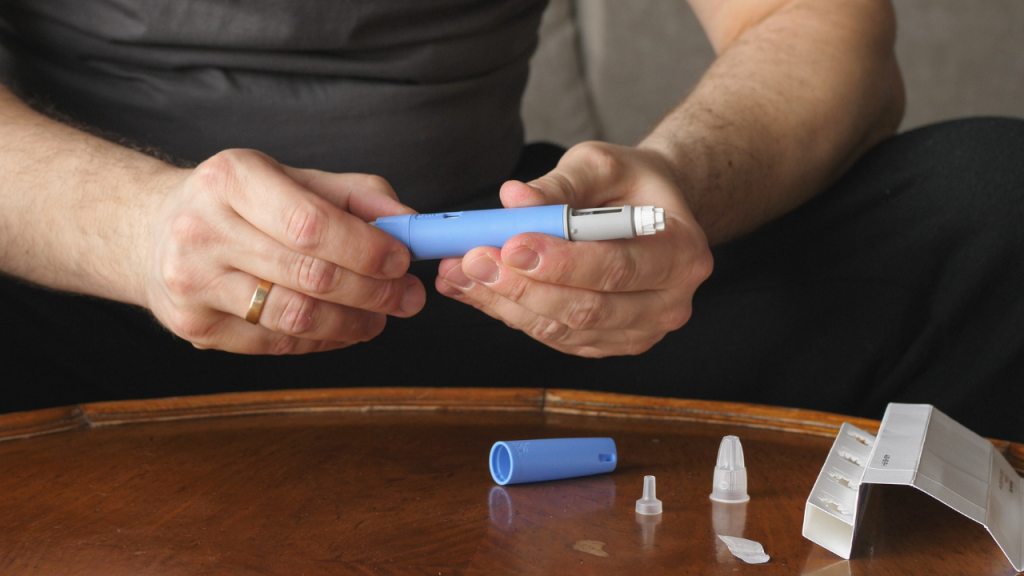The “iPhone moment” for obesity treatment

By Ben Kluftinger
In early March, Novo Nordisk held its Capital Markets Day which we attended virtually. Quite unusually, the day kicked off with the CEO interviewing a former obesity trial participant, Isabella Davies. Mrs Davies used to be severely obese, almost unable to move without being completely out of breath and suffered from heart failure. In the trial, she lost 30kg of body weight which gave her back her mobility and essentially saved her life. One might be tempted to dismiss this as one of those “sob stories” companies tell to make themselves look good. Maybe. But on second thoughts, obesity does kill and Novo’s new “wonder drug” Wegovy will save lives.
Obesity is an epidemic – and it matters
We have written about Wegovy before so here’s just a brief recap of the implications of obesity. In 1997, the World Health Organization (WHO) declared obesity an epidemic with very limited effect – the numbers have only got worse since and are still accelerating.
- According to the WHO, in 1990 25% of adults (> 18 years) were overweight and ~8% obese globally (BMI>30kg/m2). By 2022 these numbers increased to 43% overweight and ~16% obese. The deterioration in this data for children is even worse which is an indication of what lies ahead.
- The US is even more extreme. In 1999/2000, 30.5% of its adult population was obese and 4.7% severely obese (BMI > 40kg/m2). Just nine years later, this rose to 42.4% and 9.2% respectively.
While historically, obesity has been looked upon as a “lifestyle choice”, many health organisations are now acknowledging that obesity itself should be considered an illness. The WHO is now stating in its factsheet that “In most cases obesity is a multifactorial disease due to obesogenic environments, psycho-social factors and genetic variants.” The American National Institute for Health (NIH) did so already in 1998. The American Obesity Society followed in 2008.
Obesity is a threat to health because it affects the whole body and increases the incidence of a wide range of medical complications including: stroke, idiopathic intracranial hypertension, cataracts, obstructive sleep apnoea, hypoventilation syndrome, coronary artery disease, pancreatitis, diabetes, dyslipidaemia, hypertension, non-alcoholic fatty liver disease, gallbladder disease, polycystic ovarian syndrome, infertility, abnormal menses, cancer (breast, uterus, cervix, prostate, kidney, colon, oesophagus, pancreas, liver), osteoarthritis, gout, venous stasis.
In fact, there are more than 200 comorbidities associated with obesity!
Research shows that a high BMI is associated with a decreased life expectancy of up to 10 years. For every 5 kg/m2 BMI increment above the range of 22.5–25.0 kg/m2, there is a 30% increase in overall mortality.
Apart from the devastating impact on health and life expectancy, there is also a huge economic impact on the wider health system. In a much-quoted study from 2022, it was estimated that in 2019 the negative impact on global GDP amounted to 2.2%. Unsurprisingly, the highest cost was in the high-income countries costing as much as US$1110 per capita per annum. This cost is likely to rise further.
Obesity medication existed for decades – but this is its “iPhone moment”
There exists a long and chequered history of weight-reducing drugs going back as far as the 1940s. And more often than not, the side effects were substantially worse than the rather limited reduction in weight loss achieved, which was in the high single digits percent of body weight at best.
What we are observing now is nothing short of a revolutionary moment comparable in impact to the 2007 launch of the iPhone. This time though it is Novo Nordisk, not Apple, that is the disruptor and the product is the first-ever obesity drug (Wegovy) launched in 2021. Wegovy achieves a weight loss of 15% on average with 32% of STEP-1 trialist’s achieving over 20% of their bodyweight. This is a level that is approaching the benefits of rather invasive bariatric surgery results.
Wegovy is a drug based on a specific GLP-1 (Glucagon-like peptide) called semaglutide. It is a gut-derived peptide hormone that stimulates the secretion of insulin while sending satiety signals to the brain. Many other GLP-1s exist and have been tried but semaglutide is by far the most effective and according to one expert we spoke to it is unlikely that a better one will be found. Its stunning results have created a frenzy which sometimes borders on the outlandish; for example, we have received broker research exploring the impacts on sectors as disparate as the food packaging sector (people eating less food) to the airline industry (fewer obese passengers).
More seriously, the demand surge for Wegovy has caught everybody by surprise, including Novo Nordisk which quickly ran short of supply. One factor was the unheard-of ‘out-of-pocket’ interest. This represents the patients who are not able to claim for the cost of the medicine on their insurance policies and makes up nearly 80% of the total demand for the drug in Denmark and other European countries where it had been launched. A key additional benefit of semaglutide is a lowering of inflammation which increases its potency in tackling many of the obesity-related comorbidities more efficiently than just by lowering the bodyweight. It has already shown a 20% reduction in major adverse cardiovascular events (MACE) in the SELECT trial and numerous other indications are currently in trials tackling other cardiovascular diseases (CVD), metabolic dysfunction-associated steatohepatitis (MASH), rare endocrine disorders (RED), Alzheimer’s diseases, and others.
Novo Nordisk is at the centre of this new megatrend
Similar to the first generation of the iPhone, this is just the beginning of the obesity treatment revolution. Novo Nordisk competitor Eli Lilly has just launched a compound drug Zepbound (a different GLP-1 combined with a GIP (Gastric inhibitory polypeptide)) which has shown to produce even higher weight loss in the SURMOUNT trials. Novo Nordisk has its own follow-up drug, Cagrisema, in clinical phase 3 which so far produced results ahead of Wegovy and Zepbound. And so does Eli Lilly with retatrutide, also still in clinical trials. A few other companies like Zealand Pharma and Boehringer Ingelheim are trying to jump on the bandwagon but they appear late to the party. Company and consensus expectations are that the obesity drug market is going to grow in the high double-digit percent annually for the foreseeable future reaching a total market size north of USD$100bn by 2030 with most of that shared between Novo Nordisk and Eli Lilly.
Just to show what potential competition is up against: Novo Nordisk is currently expanding its Wegovy active pharmaceutical ingredient (API) facility in Danish Kalunborg for USD$6bn by 170,000m2 to reach a total size of 1.6 million m2 – this corresponds to half the size of “the City” of London. And there is more to come. At its Capital Markets Day in March 2024, Novo Nordisk made clear that it expects to treat a substantially larger number of patients by 2030 than its current ~40 million. Its parent, the Novo Foundation, recently announced the acquisition of Catalent, a contract manufacturing organisation (CMO) in order to speed up production. And in fact, there is a whole supply chain experiencing accelerating growth to support production including with other CMOs and the drug packaging industry.
So, is this the beginning of the end of the obesity epidemic? It’s still way too early to shout “Victory!” There are potential side effects of the medication (like nausea, diarrhoea and vomiting) to keep in mind. And cost. But for the first time in the history of obesity treatment, doctors and patients are actively seeking a drug that can kick-start and turbo-charge the journey towards weight loss. It’s hard work without this boost, as the author of this article can confirm after losing 9kg over three months via calorie-counting and an intensive sports regime. But obesity can only be truly beaten if the patient also shifts to a healthy diet and lifestyle at the same time. For many the drug provides the critical boost. Just ask Isabella Davies.
1 https://www.novonordisk.com/investors/capital-markets-day-2024.html
2 https://www.acc.org/Latest-in-Cardiology/Clinical-Trials/2023/08/23/19/18/step-hfpef
3 https://www.whebgroup.com/our-thoughts/ozempic-is-novo-nordisks-diabetes-and-weight-loss-drug-a-miracle-or-a-menace
4 https://www.who.int/news-room/fact-sheets/detail/obesity-and-overweight
5 https://www.niddk.nih.gov/health-information/health-statistics/overweight-obesity
6 https://www.ama-assn.org/topics/obesity
7 Prospective Studies C, Whitlock G, Lewington S, Sherliker P, Clarke R, Emberson J, et al. Body-mass index and cause-specific mortality in 900 000 adults: collaborative analyses of 57 prospective studies. Lancet. 2009;373(9669):1083-96.
8 Okunogbe et al., “Economic Impacts of Overweight and Obesity.” 2nd Edition with Estimates for 161 Countries. World Obesity Federation, 2022.
9 Mueller et al., “Anti-obesity drug discovery: advances and challenges”, Nat Rev Drug Discov. 2022 Mar;21(3):201-223
10 https://diabetes.medicinematters.com/en-GB/semaglutide/obesity/quick-guide-step-trials/18854832
11 https://fortune.com/europe/2024/02/05/novo-nordisk-ceo-lars-fruergaard-jorgensen-surprised-weight-loss-wegovy-ozempic-europe-out-of-pocket/
12 https://investor.lilly.com/news-releases/news-release-details/lillys-tirzepatide-shows-additional-211-weight-loss-after-12

